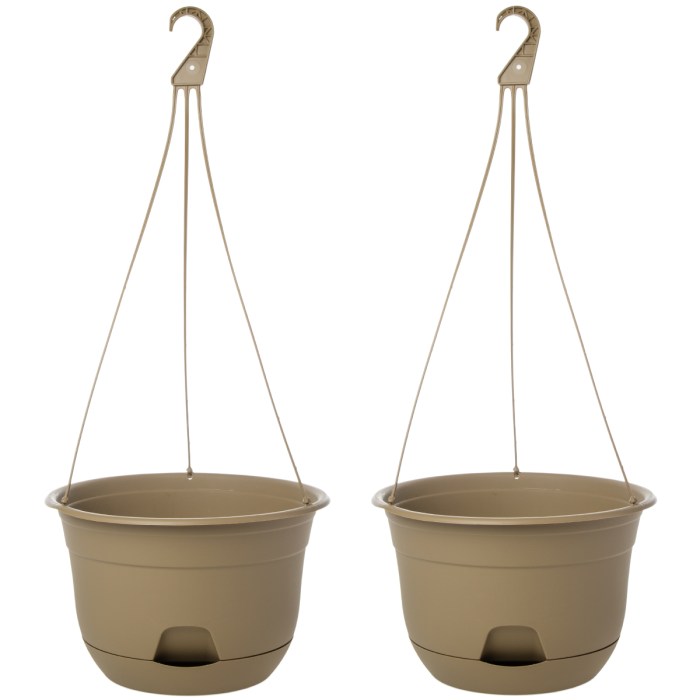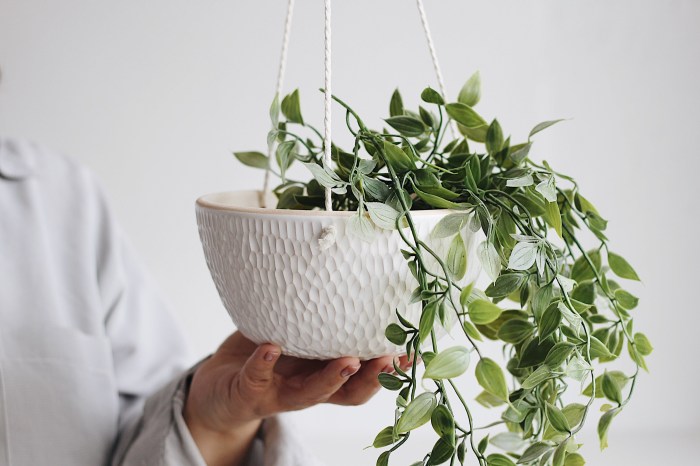Introducing indoor hanging planters with drainage, a stylish and functional solution for bringing greenery into your home. These versatile planters not only add a touch of elegance but also ensure the health and well-being of your plants by providing essential drainage.
From choosing the right plants and materials to understanding drainage systems and hanging mechanisms, this comprehensive guide will equip you with the knowledge and inspiration to create stunning indoor gardens.
Plant Compatibility

Selecting suitable plants for indoor hanging planters with drainage holes is crucial for their well-being and aesthetics. Consider the following table for guidance:
When choosing plants, consider their mature size to ensure they fit the planter’s dimensions. Light requirements vary, so research each plant’s needs and position them accordingly. Water requirements should also be considered, as overwatering or under-watering can harm plants.
Suitable Plants
| Plant | Ideal Size | Light Requirements | Water Needs |
|---|---|---|---|
| Spider Plant | Small-Medium | Bright, indirect light | Water when soil is dry to the touch |
| Pothos | Small-Large | Low to bright, indirect light | Water when soil is slightly dry |
| ZZ Plant | Small-Medium | Low to medium, indirect light | Water sparingly, only when soil is completely dry |
| Snake Plant | Small-Large | Low to bright, indirect light | Water sparingly, only when soil is completely dry |
| Philodendron Heartleaf | Small-Medium | Medium to bright, indirect light | Water when soil is slightly dry |
Planter Design and Materials
Indoor hanging planters with drainage come in a variety of designs and materials, each with its own advantages and disadvantages. The most common materials used include:
Ceramic
- Durable and long-lasting
- Comes in a wide range of colors and styles
- Heavy and can be difficult to hang
- May be susceptible to chipping or cracking
Plastic
- Lightweight and easy to hang
- Available in a variety of colors and shapes
- Not as durable as ceramic or metal
- May fade or discolor over time
Metal
- Durable and rust-resistant
- Comes in a variety of finishes, including copper, brass, and stainless steel
- Can be heavy and expensive
- May not be suitable for all plants
Wicker
- Natural and lightweight
- Adds a touch of rustic charm to any room
- May not be as durable as other materials
- Can be difficult to clean
Macrame
- Made from knotted cords or yarn
- Creates a bohemian or eclectic look
- Not as durable as other materials
- Can be difficult to hang securely
The best material for your indoor hanging planter will depend on your personal style, the size and weight of your plants, and the amount of care you are willing to give.
Drainage Systems

Adequate drainage is paramount for thriving plants in indoor hanging planters. Excess water can lead to root rot, stunted growth, and disease. Drainage systems ensure excess water is efficiently removed from the planter, creating an optimal environment for plant health.
Various drainage systems are available for indoor hanging planters. The most common method involves drainage holes in the bottom of the planter. These holes allow excess water to drain out, preventing waterlogging. Self-watering features, such as reservoirs or wicks, can also be incorporated into hanging planters.
Indoor hanging planters with drainage offer a stylish and practical way to bring greenery into your home. For a more versatile option, consider wall plant pots indoor , which can be mounted on walls or hung from ceilings. These pots are designed with drainage holes to prevent waterlogging and ensure the health of your plants.
By combining the benefits of indoor hanging planters with drainage and the flexibility of wall-mounted pots, you can create a vibrant and thriving indoor garden.
These systems provide a continuous supply of moisture to the plant while preventing overwatering.
Materials for Drainage Holes
Drainage holes can be made from various materials, each with its advantages and disadvantages:
- Plastic:Lightweight and inexpensive, plastic drainage holes are commonly found in hanging planters.
- Ceramic:Durable and aesthetically pleasing, ceramic drainage holes can add a touch of elegance to hanging planters.
- Metal:Strong and rust-resistant, metal drainage holes are suitable for outdoor hanging planters.
Hanging Mechanisms: Indoor Hanging Planters With Drainage

Suspending indoor hanging planters requires careful consideration of various hanging mechanisms to ensure stability, safety, and aesthetic appeal. Several types of hanging systems are available, each with its advantages and considerations.
Hooks, Indoor hanging planters with drainage
Hooks are a simple and versatile option for hanging planters. They come in various sizes and materials, such as metal, plastic, or wood. Hooks can be screwed into walls or ceilings, providing a secure anchor point for the planter. When using hooks, ensure they are rated to support the weight of the planter and its contents.
Brackets
Brackets offer a more robust and stable hanging solution. They are typically made of metal and consist of two or more arms that extend from the wall or ceiling to support the planter. Brackets provide better weight distribution and can accommodate larger or heavier planters.
Chains
Chains are a decorative and functional option for hanging planters. They add a touch of elegance and can be used to adjust the height of the planter. Chains should be made of durable material, such as metal or plastic, and have a sufficient weight capacity for the planter.
Indoor hanging planters with drainage provide a practical and stylish way to add greenery to your home. Whether you’re looking to create a lush indoor jungle or simply add a touch of nature to your living space, cascading plants indoor are a great option.
These plants, such as spider plants , pothos, and philodendrons, are known for their trailing stems and lush foliage. They can be easily incorporated into indoor hanging planters with drainage, allowing for excess water to drain away, preventing root rot and promoting healthy plant growth.
Ropes
Ropes provide a natural and rustic look for hanging planters. They are versatile and can be used in various ways, such as creating a macrame hanger or simply tying the planter to a hook. When using ropes, choose a sturdy material that can withstand the weight and moisture of the planter.
Installation and Adjustment
Proper installation and adjustment of hanging mechanisms are crucial for the safety and longevity of your indoor hanging planters. Follow the manufacturer’s instructions carefully when installing any hanging system. Use appropriate hardware and tools to ensure a secure and stable connection.
To adjust the height of the planter, use a ladder or step stool for safety. If using hooks or brackets, adjust the screws or bolts accordingly. For chains or ropes, simply adjust the length as desired.
Decorative Applications
Indoor hanging planters with drainage can transform a space into a lush and inviting oasis. They offer a versatile way to showcase greenery, add color, and create a sense of tranquility. By combining different plant species and planter designs, you can create eye-catching arrangements that enhance the aesthetics of any room.
One of the key advantages of hanging planters is their ability to save floor space. This makes them an ideal choice for small apartments, studios, or rooms with limited square footage. They can be suspended from ceilings, walls, or even window frames, freeing up valuable floor space for other furniture or decor.
Vertical Gardens
Hanging planters can be used to create stunning vertical gardens that add a touch of nature to any interior space. By arranging multiple planters at different heights, you can create a cascading effect that draws the eye upward. This is a great way to maximize space and bring greenery to rooms with high ceilings or limited wall space.
- For a lush and tropical look, opt for plants with large, cascading leaves, such as ferns, pothos, or philodendrons.
- To create a more structured vertical garden, choose plants with upright growth habits, such as succulents, echeverias, or snake plants.
- Consider using different sizes and shapes of planters to add visual interest to your vertical garden.
Focal Points
Hanging planters can also be used to create focal points in a room. By placing a single, large planter in a prominent location, you can draw attention to a specific area or piece of furniture. This is a great way to highlight a favorite plant, create a conversation starter, or simply add a touch of drama to a space.
- For a bold statement, choose a planter in a vibrant color or with an eye-catching design.
- To create a more subtle focal point, opt for a planter in a neutral color with a simple design.
- Consider hanging the planter at a slightly lower height to make it more accessible and inviting.
Grouping and Arrangements
Grouping multiple hanging planters together can create a stunning visual impact. By varying the sizes, shapes, and colors of the planters, you can create a dynamic and cohesive display. This is a great way to add interest to a blank wall, create a privacy screen, or simply add a touch of greenery to a room.
- For a cohesive look, choose planters in a similar color palette or with a common design element.
- To create a more eclectic display, mix and match different styles and colors of planters.
- Consider hanging the planters at different heights to add depth and dimension to your arrangement.
Last Word
Whether you’re a seasoned plant enthusiast or a novice gardener, indoor hanging planters with drainage offer a unique way to enjoy the beauty and benefits of nature within the confines of your home. With proper care and attention, these planters will thrive, adding a touch of serenity and vitality to your living space.
Questions and Answers
What are the benefits of using indoor hanging planters with drainage?
Indoor hanging planters with drainage offer several benefits, including improved plant health, reduced waterlogging, better air circulation, and enhanced aesthetics.
What types of plants are suitable for indoor hanging planters with drainage?
A wide range of plants can thrive in indoor hanging planters with drainage, including ferns, succulents, trailing plants, and small flowering plants. Choose plants that suit your light conditions and watering preferences.
How do I ensure proper drainage in my indoor hanging planters?
To ensure proper drainage, choose planters with drainage holes at the bottom. You can also add a layer of gravel or pebbles to the bottom of the planter to facilitate drainage.